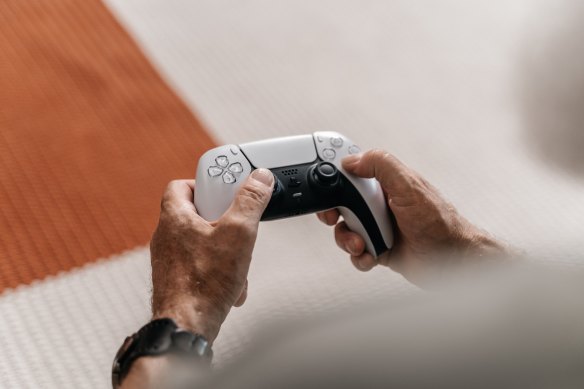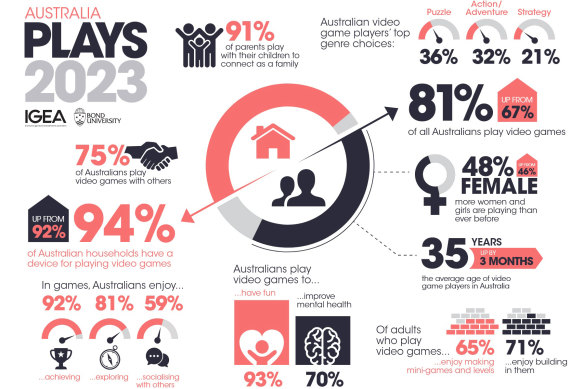
Save articles for later
Add articles to your saved list and come back to them any time.
Australia’s average video game player is 35 years old, has been playing for 11 years, and is equally likely to be male or female.
More than four in five Australians play video games, and tend to do so for more than an hour a day. And yet, retrograde stereotypes and assumptions continue to pervade mainstream discussions of the medium, and threaten to squander some of the opportunities it brings.
Research published in August, based on a survey of more than 1200 households, shows a wide and growing audience for games in Australia. Those who don’t game at all are by far in the minority. The proportion of the population that plays grew by 14 percentage points since 2021, to 81 per cent.
The teen and young adult demographics still have the highest percentage of players, but older groups aren’t far behind.
The research, commissioned by peak industry body the Interactive Games and Entertainment Association and conducted by Bond University, is the 10th of its kind since 2005. But IGEA chief executive Ron Curry said many people’s misconceptions about games, or even their failure to realise that they themselves play games, remained a problem for advocacy.
“It’s frustrating that year after year we produce this data, and yet we’re still trying to convince people that games are just not a niche product,” he said.
“Quite often we will sit down with policymakers or politicians who say they don’t play games, and we’ll just ask them, what’s on your phone? What do you do when you’re sitting on a plane? What is the first thing to do in the morning? You don’t have to be in a first-person shooter to be engaged with video games.”
The proportion of Australians who play games has jumped from 67 per cent to 81 per cent since 2021.Credit: Source: Australia Plays (Aug 2023, Bond University)
And such thinking is not only a problem for funding, regulating and celebrating games. It has wider economic implications as well. While advertising is prominent on free-to-play smartphone-based games, advertisers have largely struggled to reach the gaming audience at large.
“You know, 21 per cent of game players are under the age of 18, so there’s a huge opportunity to advertise to the rest,” Curry said.
“But it needs to be nuanced, and it needs to fit in to the feel and the style of the game.”
The most conservative estimates of global video game revenue in 2022 put it at almost $300 billion, much more than the movie and music industries combined. IGEA figures have Australians specifically spending $4.21 billion; $2.65 billion related to console and PC games, $1.56 billion for mobile.
The most recent report also showed that 91 per cent of parents reported playing games with their children, 59 per cent of adults said they enjoyed socialising in games, one third of players said they’d made a new friend inside a game, and only a quarter said they always play solo.
While the game-playing audience has grown across every demographic since 2021, there have been some exceptional leaps, for example in older Australians. The report shows that 74 per cent of 65 to 74 year olds now play (up from 47 per cent), and 58 per cent of 75 to 84 year olds (up from 31 per cent). The report authors put this down to the pandemic, which forced people to turn to screens and digital media for their communication and entertainment, and in some cases learn to use tablets and PCs for the first time.
Teenage girls also were shown to be playing more than teenage boys for the first time since the reports began. The two cohorts are fairly close in playing for about two hours a day on average. Curry said this was probably a result of the designs and marketing for games becoming both broader and more gender-neutral.
“I think it bodes well for the industry. If you’ve got 81 per cent of the population engaging in video games, they want to see themselves in a video game,” he said.
“They want a gender mix, they want different representations in the game, reflective of society.”
The report’s lead author, Professor Jeffrey Brand, said the overall split between male and female was not statistically significant given the sample size. The reported figures are 48 per cent female, 52 per cent male and a 10th of one per cent non-binary. The average player age of 35 is slightly higher than the last report, but the amount of experience the average player has is falling, as new players of all ages join in.
“Our mainstream discourse around who qualifies as a video game player still hasn’t evolved because we haven’t really acknowledged that games have moved on from the 1980s, 1990s console,” Brand said.
“The democratisation of games is very real, and when we stop and think about it we go ‘oh yeah, of course’. But I think we’re still buying into a dated stereotype about what video games are.”
Brand, who started his own gaming journey with 1970s electronics like the Merlin and the Atari 2600, said some people who didn’t grow up with gaming can feel like there’s a fundamental difference between “real games” and the kind they themselves play in their downtime, when that isn’t necessarily the case.
He equated it to the difference between someone who considers themselves an avid novel reader, and someone who reads for pleasure less often or reads shorter form content.
“If you read short stories and nonfiction, or short fiction, you are still a reader. And you can be someone who enjoys cinema, even if you just watch a bit of it,” he said.
“Games are just like every other medium in that respect. There are a lot of casual games, there are a lot of in-depth games. Big businesses make games, but so do really small developers. There’s something for everyone. And that’s not different from television or books or films.”
Get news and reviews on technology, gadgets and gaming in our Technology newsletter every Friday. Sign up here.
Most Viewed in Technology
From our partners
Source: Read Full Article

